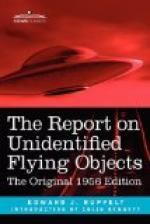Then the UFO’s were habitually reported from areas around “technically interesting” places like our atomic energy installations, harbors, and critical manufacturing areas. Our studies showed that such vital military areas as Strategic Air Command and Air Defense Command bases, some A-bomb storage areas, and large military depots actually produced fewer reports than could be expected from a given area in the United States. Large population centers devoid of any major “technically interesting” facilities also produced few reports.
According to the laws of normal distribution, if UFO’s are not intelligently controlled vehicles, the distribution of reports should have been similar to the distribution of population in the United States—it wasn’t.
Our study of the geographical locations of sightings also covered other countries. The U.S. by no means had a curb on the UFO market.
In all of our “Unknown” reports we never found one measurement of size, speed, or altitude that could be considered to be even fairly accurate. We could say only that some of the UFO’s had been traveling pretty fast.
As far as radar was concerned, we had reports of fantastic speeds— up to 50,000 miles an hour—but in all of these instances there was some doubt as to exactly what caused the target. The highest speeds reported for our combination radar-visual sightings, which we considered to be the best type of sighting in our files, were 700 to 800 miles an hour.
We had never picked up any “hardware”—any whole saucers, pieces, or parts—that couldn’t be readily identified as being something very earthly. We had a contract with a materials-testing laboratory, and they would analyze any piece of material that we found or was sent to us. The tar-covered marble, aluminum broom handle, cow manure, slag, pieces of plastic balloon, and the what-have-you that we did receive and analyze only served to give the people in our material lab some practice and added nothing but laughs to the UFO project.
The same went for the reports of “contacts” with spacemen. Since 1952 a dozen or so people have claimed that they have talked to or ridden with the crews of flying saucers. They offer affidavits, pieces of material, photographs, and other bits and pieces of junk as proof. We investigated some of these reports and could find absolutely no fact behind the stories.
We had a hundred or so photos of flying saucers, both stills and movies. Many were fakes—some so expert that it took careful study by photo interpreters to show how the photos had been faked. Some were the crudest of fakes, automobile hub caps thrown into the air, homemade saucers suspended by threads, and just plain retouched negatives. The rest of the still photos had been sent in by well-meaning citizens who couldn’t recognize a light flare of flaw in the negative, or who had chanced to get an excellent photo of a sundog or mirage.




